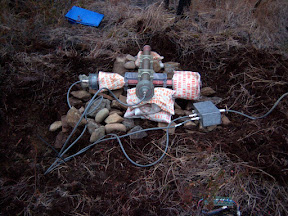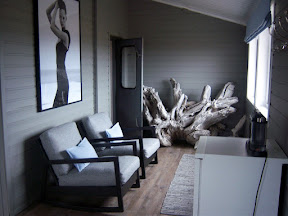I am in Alaska. I was reminded by a few people that I needed to update what was going on up here.
I arrived in Fairbanks after almost 20 hours after leaving my house around 4:00AM.

No one should have to wake up this early
The amazing thing was, most of the packages I needed arrived on the same day I arrived! Cables, computers, imager. It was a good day and a change from the fiasco of mailing something to Svalbard.


Friday, I began trying to figure out why there was noise in the ULF coils. I was shown where the coil was located, where my acquisition was packed and I got to work. I found a cut in the jacket of the main sensor cable. Someone had wrapped about three inches of duct tape around the cut to seal it off. I don't know if that happened during brush clearing or earlier in the year, but that is not good. I am going to receive special
silicone tape to repair the jacket. The rest of the main sensor cable was fine which means I don't have to try to move the 70 lb coil of cable through the woods.


The cut in the jacket allowed moisture to enter into the cable causing corrosion at the connector and inside the junction box. I was able to shake the main cable and have water fall out of it. It seems like one of the main problemn is figuring how to avoid moisture.


There was still the issue of noise. Both of my coils are showing the exact same signal. The coils generally show a similar signal, but never the exact same. It leads me to believe it is a man made signal. A few years ago, there was a fire that swept through the area. Most of the trees are blackened and dead. There is some foliage growing a few research groups are investigating regrowth of forests. Unfortunately, the regrowth experiment about 200 feet away from my ULF coils has a humming generator that is the most likely cause for my noise. My coils have a noise floor of about 400mV when we desire something more like 20mV. Tomorrow, I get to try and contact the research group and ask if we can turn off the generator, or I might be relocating the coils to the other end of the forest area.

Scope output at the acquisition system for the coils.
Sunday, before I could adequately say it was the generator causing the problem, I gave up troubleshooting and decided to go onto my second objective: ELF coil installation. The cable was only about 200 feet long, as opposed to the 1000 feet of the ULF coils, so the commute back and forth to the ELF coil is much faster. In addition to my digging in the hard ground, I carried four backpack loads of rocks down to the site. I should have lifted more weights before this field trip.

When I tested the ELF coil in my lab, the coil, data receiver, and acquisition system all worked perfectly. Somewhere between Durham and Fairbanks, something happened. The data receiver's automatic gain controller has started going crazy. It will turn on to full strength, slowing drop to zero, then quickly go back to full. It repeats this for as long as I have the system turned on. I have much less experience with the ELF systems than the ULF, so trying to troubleshoot this problem has been much more of an issue.
My last objective up here has been to image aurora. Problem 1: The controller sent by Fed-Ex has still not arrived. I'm told it is to be here tomorrow. Problem 2: It has been crazy cloudy the entire time I have been here. Problem 3 and probably the biggest: there has been little aurora activity. Heh, I just checked the plots for the solar wind and
magnetic field measurements and it looks like tonight would be a good night for the aurora. When the blue line dips below about 50 nT and the magnetic field is negative, that is an indication activity should be happening soon. I wish I had the controller! It is also supposed to be the clearest night this week!
Alaska is kind of a funny place. It seems like people really like living here. I almost feel like I am back in Texas for all the pride that is shown. There are electrical cords sticking out the front of everyone's car to keep them warm during the winter.

It seems like I just missed the fall. Bare trees were everywhere, there is a winter crispness in the air, and I heard there was snow flurries last week. I'm glad the ground hadn't frozen quite yet, as I was still able to dig a hole for my ELF coils.
It has been really nice not being up here by myself. The two guys from Dartmouth, David and Matt, have been great to hang out with. David has much more electrical knowledge then I ever will have and has been great to ask for troubleshooting advice.
This morning I felt a little under the weather, but a couple cups of tea and trying to stay inside for most of the day, I think has helped keep the cold at bay. I can be sick Saturday, but this week, I have things to do!



























































